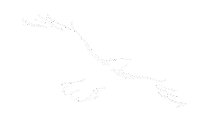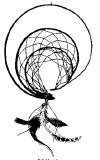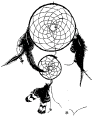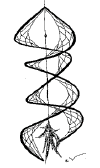The Soul of the Indian
Eastman, Charles Alexander (1911)
This was the first dividing of the trail between man and
the animal people, and when the animals had sued for peace, the treaty
provided that they must ever after furnish man with flesh for his food and
skins for clothing, though not without effort and danger on his part. The
little insects refused to make any concession, and have ever since been the
tormentors of man; however, the birds of the air declared that they would
punish them for their obstinacy, and this they continue to do unto this day.
Our people have always claimed that the stone arrows which
are found so generally throughout the country are the ones that the first
man used in his battle with the animals. It is not recorded in our
traditions, much less is it within the memory of our old men, that we have
ever made or used similar arrow-heads. Some have tried to make use of them
for shooting fish under water, but with little success, and they are
absolutely useless with the Indian bow which was in use when America was
discovered. It is possible that they were made by some pre-historic race who
used much longer and stronger bows, and who were workers in stone, which our
people were not. Their stone implements were merely natural boulders or
flint chips, fitted with handles of raw-hide or wood, except the pipes,
which were carved from a species of stone which is soft when first quarried,
and therefore easily worked with the most primitive tools. Practically all
the flint arrowheads that we see in museums and elsewhere were picked up or
ploughed up, while some have been dishonestly sold by trafficking Indians
and others, embedded in trees and bones.
We had neither devil nor hell in our religion until the
white man brought them to us, yet Unk-to-mee, the Spider, was doubtless akin
to that old Serpent who tempted mother Eve. He is always characterized as
tricky, treacherous, and at the same time affable and charming, being not
without the gifts of wit, prophecy, and eloquence. He is an adroit magician,
able to assume almost any form at will, and impervious to any amount of
ridicule and insult. Here we have, it appears, the elements of the story in
Genesis; the primal Eden, the tempter in animal form, and the bringing of
sorrow and death upon earth through the elemental sins of envy and jealousy.
The warning conveyed in the story of Unk-to-mee was ever
used with success by Indian parents, and especially grandparents, in the
instruction of their children. Ish-na-e-cha-ge, on the other hand, was a
demigod and mysterious teacher, whose function it was to initiate the first
man into his tasks and pleasures here on earth.
After the battle with the animals, there followed a battle
with the elements, which in some measure parallels the Old Testament story
of the flood. In this case, the purpose seems to have been to destroy the
wicked animal people, who were too many and too strong for the lone man.
The legend tells us that when fall came, the First-Born
advised his younger brother to make for himself a warm tent of buffalo
skins, and to store up much food. No sooner had he done this than it began
to snow, and the snow fell steadily during many moons. The Little Boy Man
made for himself snow-shoes, and was thus enabled to hunt easily, while the
animals fled from him with difficulty. Finally wolves, foxes, and ravens
came to his door to beg for food, and he helped them, but many of the
fiercer wild animals died of cold and starvation.
One day, when the hungry ones appeared, the snow was
higher than the tops of the teepee poles, but the Little Boy Man's fire kept
a hole open and clear. Down this hole they peered, and lo! the man had
rubbed ashes on his face by the advice of his Elder Brother, and they both
lay silent and motionless on either side of the fire.
Then the fox barked and the raven cawed his signal to the
wandering tribes, and they all rejoiced and said: "Now they are both dying
or dead, and we shall have no more trouble!" But the sun appeared, and a
warm wind melted the snow-banks, so that the land was full of water. The
young man and his Teacher made a birch-bark canoe, which floated upon the
surface of the flood, while of the animals there were saved only a few, who
had found a foothold upon the highest peaks.
The youth had now passed triumphantly through the various
ordeals of his manhood. One day his Elder Brother spoke to him and said:
"You have now conquered the animal people, and withstood the force of the
elements. You have subdued the earth to your will, and still you are alone!
It is time to go forth and find a woman whom you can love, and by whose help
you may reproduce your kind."
"But how am I to do this?" replied the first man, who was
only an inexperienced boy. "I am here alone, as you say, and I know not
where to find a woman or a mate!"
"Go forth and seek her," replied the Great Teacher; and
forthwith the youth set out on his wanderings in search of a wife. He had no
idea how to make love, so that the first courtship was done by the pretty
and coquettish maidens of the Bird, Beaver, and Bear tribes. There are some
touching and whimsical love stories which the rich imagination of the Indian
has woven into this old legend.
It is said, for example, that at his first camp he had
built for himself a lodge of green boughs in the midst of the forest, and
that there his reverie was interrupted by a voice from the wilderness -- a
voice that was irresistibly and profoundly sweet. In some mysterious way,
the soul of the young man was touched as it had never been before, for this
call of exquisite tenderness and allurement was the voice of the eternal
woman!
Presently a charming little girl stood timidly at the door
of his pine-bough wigwam. She was modestly dressed in gray, with a touch of
jet about her pretty face, and she carried a basket of wild cherries which
she shyly offered to the young man. So the rover was subdued, and love
turned loose upon the world to upbuild and to destroy! When at last she left
him, he peeped through the door after her, but saw only a robin, with head
turned archly to one side, fluttering away among the trees.
His next camp was beside a clear, running stream, where a
plump and industrious maid was busily at work chopping wood. He fell
promptly in love with her also, and for some time they lived together in her
cosy house by the waterside. After their boy was born, the wanderer wished
very much to go back to his Elder Brother and to show him his wife and
child. But the beaver-woman refused to go, so at last he went alone for a
short visit. When he returned, there was only a trickle of water beside the
broken dam, the beautiful home was left desolate, and wife and child were
gone forever!
The deserted husband sat alone upon the bank, sleepless
and faint with grief, until he was consoled by a comely young woman in
glossy black, who took compassion upon his distress and soothed him with
food and loving attentions. This was the bear-woman, from whom again he was
afterward separated by some mishap. The story goes that he had children by
each of his many wives, some of whom resembled their father, and these
became the ancestors of the human race, while those who bore the
characteristics of their mother returned to her clan. It is also said that
such as were abnormal or monstrous in form were forbidden to reproduce their
kind, and all love and mating between man and the animal creation was from
that time forth strictly prohibited. There are some curious traditions of
young men and maidens who transgressed this law unknowingly, being seduced
and deceived by a magnificent buck deer, perhaps, or a graceful doe, and
whose fall was punished with death.
The animal totems so general among the tribes were said to
have descended to them from their great-grandmother's clan, and the legend
was often quoted in support of our close friendship with the animal people.
I have sometimes wondered why the scientific doctrine of man's descent has
not in the same way apparently increased the white man's respect for these
our humbler kin.
Of the many later heroes or Hiawathas who appear in this
voluminous unwritten book of ours, each introduced an epoch in the long
story of man and his environment. There is, for example, the Avenger of the
Innocent, who sprang from a clot of blood; the ragged little boy who won
fame and a wife by shooting the Red Eagle of fateful omen; and the Star Boy,
who was the off-spring of a mortal maiden and a Star.
It was this last who fought for man against his strongest
enemies, such as Wazeeyah, the Cold or North-Wind. There was a desperate
battle between these two, in which first one had the advantage and then the
other, until both were exhausted and declared a truce. While he rested, Star
Boy continued to fan himself with his great fan of eagle feathers, and the
snow melted so fast that North-Wind was forced to arrange a treaty of peace,
by which he was only to control one half the year. So it was that the
orderly march of the seasons was established, and every year Star Boy with
his fan of eagle feathers sets in motion the warm winds that usher in the
spring.
THE GREAT MYSTERY -
2
THE FAMILY ALTAR -
2
CEREMONIAL AND SYMBOLIC WORSHIP
-
2
BARBARISM AND THE MORAL CODE
-
2
UNWRITTEN SCRIPTURES
-
2
ON THE BORDERLAND OF SPIRITS
-
2
White Eagle Soaring: Dream Dancer of the 7th Fire







 Get
a course to promote your business online, explode your sales
Get
a course to promote your business online, explode your sales Get
software to promote your business online in less time
Get
software to promote your business online in less time Get
software to streamline your business and run it hands free.
Get
software to streamline your business and run it hands free.